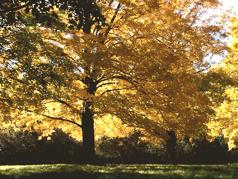
Deciduous forests grow in areas where there are four clear seasons. Most of the eastern half of the United States is in this biome, as is much of central and northern Europe, eastern China, and Japan
The forests of the temperate zones are mainly deciduous, which means that they have leaves rather than needles and that they drop these leaves in colder seasons. The leaves are covered with breathing pores or stomata and the stomata are not as protected as they are on pine needles. However, the leaves can protect themselves with pine needlelike tannin (or resin) production when they are under attack from large numbers of insects. Unlike conifers, flowers develop to seed (acorns, chestnuts, and winged seeds, for example) in only one season because of the long growing period.
When the cold season arrives, photosynthetic chlorophyll is broken down and withdrawn, and the waste products of photosynthesis remain to color the leaves different colors. Cork seals cover the vessels that carried water and nutrients to the leaves and the leaves soon drop off. Because the organic matter in the soil (the litter layer) is made of these leaves rather than of pine needles, it takes just two years to decompose the litter as compared to four years for that of conifers.
Some of the trees in southern temperate forests have adopted strategies similar to conifers—they are green all year, with waxy leaves and fewer stomata on the underside of the leaves. In addition, there are conifers in most temperate forests and in the more southerly forests.
Conifers have an important advantage—the needles that protect against cold and snow in northern climates can also protect against drought caused by heat in the south. Pines in the south are shaped differently, however, from those in the north. Their branches typically go straight out or upwards, while the branches on northern pines often droop down; snow will not easily break the branches.
Many mammals live in burrows during the winter, living off their accumulated fat or stores of food. Larger animals like bear sleep relatively lightly through their hibernation, but some smaller mammals fall into a curled up, cold position that to the observer looks like death. A woodchuck slows its heart rate from eighty beats a minute to just four!
Mutual Relationships Among Plants and Animals
Animals in deciduous forests help spread or disperse the seeds of plants and in turn live on some of their fruits, berries, bark, and leaves. They are kept from eating too much, however, by plant defenses such as thorns and toxic chemicals.
Rapid urbanization, suburban sprawl, and pollution remain serious challenges for this biome. Large carnivores such as bears and wolves have suffered the most from human intrusion. In addition, these forests have been cleared through logging in North America and Europe. Because the forests are then replanted in a single species, they become more vulnerable to disease.